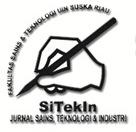Analisis Kecacatan Crude Palm Oil (CPO) Menggunakan Metode Quality Control Circle (QCC) di PT. Ujong Neubok Dalam
Abstract
Full Text:
PDFReferences
M. H. Alim and S. Suseno, “Analisa Persediaan Bahan Baku Menggunakan Metode Continuous Review System dan Periodic Review System di PT XYZ,” J. Teknol. dan Manaj. Ind. Terap., vol. 1, no. III, pp. 163–172, 2022.
A. Firdaus and F. Yuamita, “Upaya Pencegahan Kecelakaan Kerja Pada Proses Grading Tbs Kelapa Sawit Di PT. Sawindo Kencana Menggunakan Metode Job Safety Analysis (JSA),” J. Teknol. dan Manaj. Ind. Terap., vol. 1, no. III, pp. 155–162, 2022.
N. Yuniva, “Analisa Mutu Crude Palm Oil (Cpo) Dengan Parameter Kadar Asam Lemak Bebas (Alb), Kadar Air Dan Kadar Zat Pengotor Di Pabrik Kelapa Sawit Pt. Perkebunan Nusantara-V Tandun Kabupaten Kampar.” Universitas Islam Negeri Sultan Syarif Kasim Riau, 2010.
D. Dewianawati, M. Efendi, and S. R. Oksaputri, “Pengaruh Kecerdasan Emosional, Kompetensi, Komunikasi dan Displin Kerja Terhadap Kineja Karyawan,” J. Teknol. dan Manaj. Ind. Terap., vol. 1, no. III, pp. 223–230, 2022.
R. T. Wright and I. E. Wiyono, “Indonesia oilseeds and products annual 2014,” Washington, DC United States Dep. Agric., 2014.
Y. Nursyanti, “Penentuan Penyedia Jasa Trucking di PT Yicheng Logistics Dengan Menggunakan Metode SAW (Simple Additive Weighting),” J. Teknol. dan Manaj. Ind. Terap., vol. 1, no. III, pp. 210–222, 2022.
V. A. Nuantra et al., “Faktor Usability Testing Terhadap Penggunaan Presensi Di Web SIA UTY,” J. Teknol. dan Manaj. Ind. Terap., vol. 1, no. III, pp. 173–182, 2022.
R. Khatun, M. I. H. Reza, M. Moniruzzaman, and Z. Yaakob, “Sustainable oil palm industry: The possibilities,” Renew. Sustain. Energy Rev., vol. 76, pp. 608–619, 2017.
F. B. Ahmad, Z. Zhang, W. O. S. Doherty, and I. M. O’Hara, “The outlook of the production of advanced fuels and chemicals from integrated oil palm biomass biorefinery,” Renew. Sustain. Energy Rev., vol. 109, pp. 386–411, 2019.
H. Purnomo et al., “Reconciling oil palm economic development and environmental conservation in Indonesia: A value chain dynamic approach,” For. Policy Econ., vol. 111, p. 102089, 2020.
S. Sumathi, S. P. Chai, and A. R. Mohamed, “Utilization of oil palm as a source of renewable energy in Malaysia,” Renew. Sustain. energy Rev., vol. 12, no. 9, pp. 2404–2421, 2008.
D. Diniaty, F. Hanum, and M. I. Hamdy, “Analisis Pengendalian Mutu (Quality Control) CPO (Crude Palm Oil) pada PT. XYZ,” J. Tek. Ind, vol. 5, no. 2, pp. 92–99, 2019.
M. Nur, Y. E. P. Dasneri, and A. Masari, “Pengendalian Kualitas Crude Palm Oil (CPO) di PT. Sebanga Multi Sawit,” J. Tek. Ind. J. Has. Penelit. dan Karya Ilm. dalam Bid. Tek. Ind., vol. 5, no. 2, p. 148, 2020, doi: 10.24014/jti.v5i2.8985.
M. Nur and S. Wahyuni, “Analisis Kualitas Crude Palm Oil (CPO) Di PT. Inti Indo Sawit PMKS Subur Buatan 1 Siak,” ejournal.uin-suska.ac.id, Accessed: Jun. 13, 2022. [Online]. Available: http://ejournal.uin-suska.ac.id/index.php/jti/article/view/9168.
C. Brandi, T. Cabani, C. Hosang, S. Schirmbeck, L. Westermann, and H. Wiese, “Sustainability standards for palm oil: challenges for smallholder certification under the RSPO,” J. Environ. Dev., vol. 24, no. 3, pp. 292–314, 2015.
M. I. H. Umam, N. Nofirza, M. Rizki, and F. S. Lubis, “Optimalisasi Jumlah Kebutuhan Tenaga Kerja pada Stasiun Kerja Hoisting Crane Menggunakan Metode Work Sampling (Studi Kasus: PT. X),” J. Tek. Ind. J. Has. Penelit. dan Karya Ilm. dalam Bid. Tek. Ind., vol. 5, no. 2, pp. 125–129, 2020.
A. S. M. Absa and S. Suseno, “Analisis Pengendalian Kualitas Produk Eq Spacing Dengan Metode Statistic Quality Control (SQC) Dan Failure Mode And Effects Analysis (FMEA) Pada PT. Sinar Semesta,” J. Teknol. dan Manaj. Ind. Terap., vol. 1, no. III, pp. 183–201, 2022.
P. Priyono and F. Yuamita, “Pengembangan Dan Perancangan Alat Pemotong Daun Tembakau Menggunakan Metode Quality Function Deployment (QFD),” J. Teknol. dan Manaj. Ind. Terap., vol. 1, no. III, pp. 137–144, 2022.
G. A. Pratiwi, R. Nurcahyo, and M. Dachyar, “Quality Control Circle Effect on Employee Morale and Company Performance in Indonesia,” in 2019 IEEE 6th International Conference on Engineering Technologies and Applied Sciences (ICETAS), 2019, pp. 1–5.
O. A. W. Riyanto, “Implementasi metode quality control circle untuk menurunkan tingkat cacat pada produk alloy wheel,” J. Eng. Manag. Ind. Syst., vol. 3, no. 2, 2015.
Y. Syahrullah and M. R. Izza, “Integrasi FMEA dalam penerapan quality control circle (QCC) untuk perbaikan kualitas proses produksi pada mesin tenun rapier,” J. Rekayasa Sist. Ind., vol. 6, no. 2, pp. 78–85, 2021.
X. Shi et al., “Application of Quality Control Circle in the Management of Drug Repercussion in Outpatient Pharmacy of Our Hospital,” China Pharm., pp. 25–28, 2018.
X. I. E. Shuying, “Application of quality control circle in quality improvement of nursing shift in endocrinology department,” Chinese J. Integr. Nurs., vol. 3, no. 2, p. 12, 2017.
J. Wu, X. Su, H. Lian, A. Lin, H. Wei, and J. Hu, “Quality Control Circle improves self-monitoring of blood glucose in Type 2 diabetic patients,” Aust. J. Adv. Nursing, vol. 36, no. 3, pp. 22–28, 2019.
A. T. Yulianto and H. C. Wahyuni, “Minimize Customer Return by Using the Method of Quality Control Circle and Quality Loss Fuction: Study from PT Artha Food,” PROZIMA (Productivity, Optim. Manuf. Syst. Eng., vol. 3, no. 1, pp. 43–56, 2019
DOI: http://dx.doi.org/10.24014/sitekin.v20i1.18572
Refbacks
Copyright (c) 2022 SITEKIN: Jurnal Sains, Teknologi dan Industri
 | Editorial Address: FAKULTAS SAINS DAN TEKNOLOGI UIN SULTAN SYARIF KASIM RIAU Kampus Raja Ali Haji Gedung Fakultas Sains & Teknologi UIN Suska Riau Jl.H.R.Soebrantas No.155 KM 18 Simpang Baru Panam, Pekanbaru 28293 © 2023 SITEKIN, ISSN 2407-0939 |
SITEKIN Journal Indexing:
Google Scholar | Garuda | Moraref | IndexCopernicus | SINTA

SITEKIN by http://ejournal.uin-suska.ac.id/index.php

.png)





